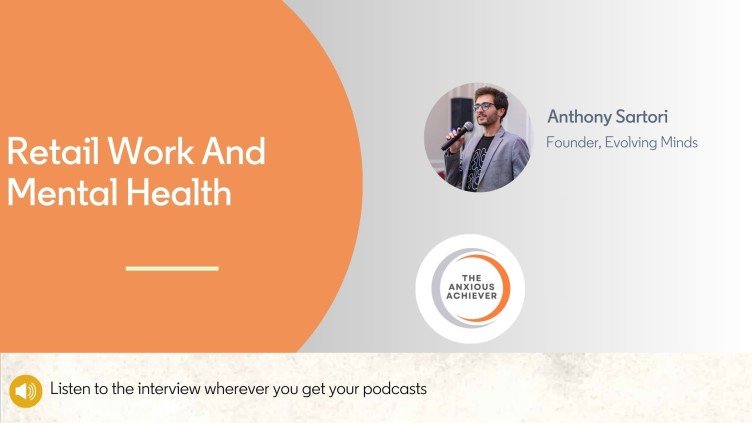Retail Workers and Mental Health
This week on The Anxious Achiever I interviewed Anthony Sartori, whose Baltimore-based non profit Evolving Minds focuses on improving workplace mental health among hourly workers. Sartori’s experience working in a grocery store during the pandemic informed his drive to help hourly workers gain access to more agency on the job and he is piloting new methods to create mindfulness, connection, and equity among teams who work in retail.
My own privilege smacked me in the face as we talked. I spend time with highly paid professionals who assume their wellbeing matters at work. That’s not true for the majority of workers. And, new research from Flex+Strategy Group finds aside from the time when the pandemic forced most employees to work remotely, there’s been little change during the past decade in where employees say they do most of their work. A majority (68%) still do most of their work onsite at their employer’s location while nearly a third (32%) do most of their work from a remote location, which includes home, business center or another location.
Workplace inequity is ubiquitous across America. Sartori says “One third of workers make $15 an hour or less. Millions of people don't have enough money to meet basic human needs. Only 23% of workers have access to paid family leave. Many women have to go back to work right after giving birth. A big part of our mission is to disrupt workplace inequality because it's everywhere. When you go into a tech company and you look around you see who has power and who doesn't, who's cleaning the facility, who's the security guard; it becomes very clear that that inequity is a big driving force of the mental health crisis. It is something that we seek to change and a big part of the mission at Evolving Minds.”
I asked Sartori: what do leaders of organizations need to know about the mental health of their hourly workers?
Sartori stressed, “Come into the store-- there's a huge disconnect between senior leaders and what's happening in the store. I think the biggest thing is to engage workers in workplace decisions, which is tough but necessary. [When I was working at the grocery store] almost every shift, decisions were made about my work environment without ever asking me or any of my coworkers… and we're just confused. Do you know what our reality is? You want us to do this, this, and this? We're barely keeping this afloat during the very serious parts of the pandemic where thousands of people are dying a day. It is all interconnected. It's the wage, the work environment, it all impacts our mental health and wellbeing."
In his work, Sartori finds peer to peer connection one of the key, evidence-based factors that helps teams coalesce. He notes in retail there's often no time or space for community and connection. In Sartori’s experience, managers were moved from store to store so frequently there was no time to forge connection and trust. “They came into the store with a checklist to see how we’re doing, but nowhere on that checklist did it say, how is the team doing? How's the mental health and wellbeing of the team members? It was just operational things.”
It’s essential to intentionally build in time for peer connections. Sartori says, "The people that I worked with that I cared about so much, many of them were very community-based people. We had artists in our store, we had painters, we had playwrights, we had actors, we had metalsmiths, we had writers. And there wasn't a time or space for us to really intentionally get to know one another. Given the intensity of retail, the pace of the work, we can make a case that it's even more important for us to be slowing down and connecting. Retail is often seen as people come and go. The expectation is that people won't stay there in that environment very long. But I think if we changed that and we built in community and connection and culture, people would stay. People would not be cycling in and out."
With teams, Evolving Minds builds in 20 minutes weekly or biweekly of protected, intentional time and space devoted to building culture. “That's it. It's very powerful,” says Sartori. That's where team members practice those work culture skills. Like, how could we have conversations about workplace compensation? So they have those conversations together as a group. And I think that's pretty radical in many ways to have these conversations as an organization…
It's why our model has shown over a 30% reduction in symptoms of depression, anxiety, and stress. We saw a 57% reduction in callouts within the first two months.”

